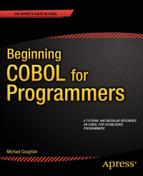![]()
The previous chapter dealt with COBOL’s selection constructs: IF and EVALUATE. In this chapter, you examine the last of the classic structured programming constructs: iteration.
In almost every programming job, there is some task that needs to be done over and over again. The job of processing a file of records is an iteration of this task: get and process record. The job of getting the sum of a stream of numbers is an iteration of this task: get and add number. The job of searching through an array for a particular value is an iteration of this task: get next element and check element value. These jobs are accomplished using iteration constructs.
Other languages support a variety of iteration constructs, each designed to achieve different things. In Modula-2 and Pascal, While..DO and Repeat..Until implement pre-test and post-test iteration. The for loop is used for counting iteration. The many C-language derivatives use while and do..while for pre-test and post-test iteration, and again the for loop is used for counting iteration.
COBOL supports all these different kinds of iteration, but it has only one iteration construct: the PERFORM verb (see Table 6-1). Pre-test and post-test iteration are supported by PERFORM WITH TEST BEFORE and PERFORM WITH TEST AFTER. Counting iteration is supported by PERFORM..VARYING. COBOL even has variations that are not found in other languages. PERFORM..VARYING, for instance, can take more than one counter, and it has both pre-test and post-test variations. Whereas in most languages the loop target is an inline block of code, in COBOL it can be either an inline block or a named out-of-line block of code.
Table 6-1. Iteration Constructs and Their COBOL Equivalents

In the PROCEDURE DIVISION, a paragraph is a block of code to which you have given a name. A paragraph begins with the paragraph name (see Example 6-1) and ends when the next paragraph or section name is encountered or when the end of the program text is reached. The paragraph name must always be terminated with a period (full stop).
There may be any number of statements and sentences in a paragraph; but there must be at least one sentence, and the last statement in the paragraph must be terminated with a period. In fact, as I mentioned in the previous chapter, there is a style of COBOL programming called the minimum-period style1-2, which you should adopt. This style suggests that there should be only one period in the paragraph. It is particularly important to adhere to this style when coding inline loops, because a period has the effect of delimiting the scope of an inline PERFORM.
Example 6-1. Two Paragraphs: ProcessRecord Ends Where ProcessOutput Begins
ProcessRecord.
DISPLAY StudentRecord
READ StudentFile
AT END MOVE HIGH-VALUES TO StudentRecord
END-READ.
ProduceOutput.
DISPLAY "Here is a message".
The PERFORM Verb
Unless it is instructed otherwise, a computer running a COBOL program processes the statements in sequence, starting at the first statement of the PROCEDURE DIVISION and working its way down through the program until the STOP RUN, or the end of the program text, is reached. The PERFORM verb is one way of altering the sequential flow of control in a COBOL program. The PERFORM verb can be used for two major purposes;
- To transfer control to a designated block of code
- To execute a block of code iteratively
Whereas the other formats of the PERFORM verb implement iteration of one sort or another, this first format is used to transfer control to an out-of-line block of code—that is, to execute an open subroutine. You have probably have come across the idea of a subroutine before. A subroutine is a block of code that is executed when invoked by name. Methods, procedures, and functions are subroutines. You may not have realized that there are two types of subroutine:
- Open subroutines
- Closed subroutines
If you have learned BASIC, you may be familiar with open subroutines. If you learned C, Modula-2, or Java, you are probably familiar with closed subroutines.
An open subroutine is a named block of code that control (by which I mean program statement execution) can fall into, or through. An open subroutine has access to all the data items declared in the main program, and it cannot declare any local data items.
Although an open subroutine is normally executed by invoking it by name, it is also possible, unless you are careful, to fall into it from the main program. In BASIC, the GOSUB and RETURN commands allow you to implement open subroutines. Example 6-2 is a short BASIC program that illustrates the fall-through problem. Two outputs are provided: one where the EXIT statement prevents fall-through and the other where control falls through into OpenSub because the EXIT statement has been removed.
Example 6-2. Open Subroutine in Yabasic3 Showing Output With and Without the EXIT Statement
REM Demonstrates Open subroutines in Yabasic
REM When the EXIT is removed, control falls
REM through into OpenSub
REM Author. Michael Coughlan
PRINT "In main"
GOSUB OpenSub
PRINT "Back in main"
EXIT
LABEL OpenSub
PRINT "In OpenSub"
RETURN
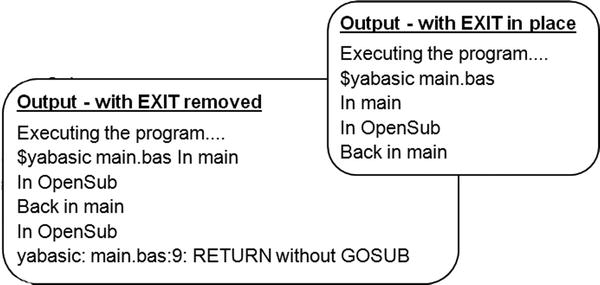
In some legacy COBOL programs, falling through the program from paragraph to paragraph is a deliberate strategy. In this scheme, which has been called gravity-driven programming, control falls through the program until it encounters an IF and GO TO combination that drives it to a paragraph in the code above it; after that, control starts to fall through the program again. Example 6-3 provides an outline of how such a program works (P1, P2, P3, and P4 are paragraph names).
Example 6-3. Model for a Gravity-Driven COBOL Program
P1.
statement
statement
statement
P2.
statement
statement
P3.
statement
IF cond GO TO P2
statement
statement
IF cond GO TO P3
P4.
statement
IF cond GO TO P2
statement
statement
STOP RUN
A closed subroutine is a named block of code that can only be executed by invoking it by name. Control cannot “fall into” a closed subroutine. A closed subroutine can usually declare its own local data, and that data cannot be accessed outside the subroutine. Data in the main program can be passed to the subroutine by means of parameters specified when the subroutine is invoked. In C and Modula-2, procedures and functions implement closed subroutines. In Java, methods are used.
COBOL supports both open and closed subroutines. Open subroutines are implemented using the first format of the PERFORM verb. Closed subroutines are implemented using the CALL verb and contained or external subprograms. You learn about contained and external subprograms later in the book.
![]() ISO 2002 ISO 2002 COBOL provides additional support for closed subroutines in the form of methods. Methods in COBOL bear a very strong syntactic resemblance to contained subprograms.
ISO 2002 ISO 2002 COBOL provides additional support for closed subroutines in the form of methods. Methods in COBOL bear a very strong syntactic resemblance to contained subprograms.
Why Use Open Subroutines?
The open subroutines represented by paragraphs (and sections) are used to make programs more readable and maintainable. Although PERFORMed paragraphs are not as robust as the user-defined procedures or functions found in other languages, they are still useful. They allow you to partition code into a hierarchy of named tasks and subtasks without the formality or overhead involved in coding a procedure or function. COBOL programmers who require the protection of that kind of formal partitioning can use contained or external subprograms.
Partitioning a task into subtasks makes each subtask more manageable; and using meaningful names for the subtasks effectively allows you to document in code what the program is doing. For instance, a block of code that prints report headings can be removed to a paragraph called PrintReportHeadings. The details of how the task is being accomplished can be replaced with a name that indicates what is being done.
Consider the partitioning and documentation benefits provided by the program skeleton in Example 6-4. The skeleton contains no real code (only PERFORMs and paragraph names), but the hierarchy of named tasks and subtasks allows you to understand that the program reads through a file containing sales records for various shops and for each shop prints a line on the report that summarizes the sales for that shop.
Example 6-4. Program Skeleton
PrintSummarySalesReport.
PERFORM PrintReportHeadings
PERFORM PrintSummaryBody UNTIL EndOfFile
PERFORM PrintFinalTotals
STOP RUN.
PrintSummaryBody.
PERFORM SummarizeShopSales
UNTIL ShopId <> PreviousShopId
OR EndOfFile
PERFORM PrintShopSummary
SummarizeShopSales.
Statements
PrintReportHeadings.
Statements
PrintShopSummary.
Statements
PrintFinalTotals.
Statements
Obviously, it is possible to take partitioning to an extreme. You should try to achieve a balance between making the program too fragmented and too monolithic. As a rule of thumb, there should be a good reason for creating a paragraph that contains five statements or fewer.
This first format of the PERFORM (see Figure 6-1) is not an iteration construct. It simply instructs the computer to transfer control to an out-of-line block of code (that is, an open subroutine). The block of code may be a paragraph or a section. When the end of the block is reached, control reverts to the statement (not the sentence) immediately following the PERFORM.

Figure 6-1. Metalanguage for PERFORM format 1
In Figure 6-1, StartblockName and EndblockName are the names of paragraphs or sections. PERFORM..THRU instructs the computer to treat the paragraphs or sections from StartblockName TO EndblockName as a single block of code.
PERFORM s can be nested. A PERFORM may execute a paragraph that contains another PERFORM, but neither direct nor indirect recursion is allowed. Unfortunately, this restriction is not enforced by the compiler, so a syntax error does not result; but your program will not work correctly if you use recursive PERFORMs.
The order of execution of the paragraphs is independent of their physical placement. It does not matter where you put the paragraphs—the PERFORM will find and execute them.
Listing 6-1 shows a short COBOL program that demonstrates how PERFORM works. The program executes as follows:
- Control starts in paragraph LevelOne, and the message “Starting to run program” is displayed.
- When PERFORM LevelTwo is executed, control is passed to LevelTwo and the statements in that paragraph start to execute.
- When PERFORM LevelThree is executed, control passes to LevelThree. When PERFORM LevelFour is executed, the message “Now in LevelFour” is displayed.
- When the end of LevelFour is reached, control returns to the statement following thePERFORMthat invoked it, and the message “Back in LevelThree” is displayed.
- When LevelThree ends, control returns to the statement following the PERFORM, and the message “Back in LevelTwo” is displayed. Finally, when LevelTwo ends, control returns to paragraph LevelOne, and the “Back in LevelOne” message is displayed.
- When STOP RUN is reached, the program stops.
Notice that the order of paragraph execution is independent of physical placement. For instance, although the paragraph LevelTwo comes after LevelThree and LevelFour in the program text, it is executed before them.
As I mentioned earlier, although PERFORMs can be nested, neither direct nor indirect recursion is allowed. So it would not be valid for paragraph LevelThree to contain the statement PERFORM LevelThree. This would be direct recursion. Neither would it be valid for LevelTwo to contain the statement PERFORM LevelOne. This would be indirect recursion because LevelOne contains the instruction PERFORM LevelTwo.
A frequent mistake made by beginning COBOL programmers is to forget to include STOP RUN at the end of the first paragraph. Example 6-5 shows the output that would be produced by Listing 6-1 if you forgot to include STOP RUN. From the output produced, try to follow the order of execution of the paragraphs.
Example 6-5. Output when STOP RUN is missing
> Starting to run program
> > Now in LevelTwo
> > > Now in LevelThree
> > > > Now in LevelFour
> > > Back in LevelThree
> > Back in LevelTwo
> Back in LevelOne
> > > > Now in LevelFour
> > > Now in LevelThree
> > > > Now in LevelFour
> > > Back in LevelThree
> > Now in LevelTwo
> > > Now in LevelThree
> > > > Now in LevelFour
> > > Back in LevelThree
> > Back in LevelTwo
Listing 6-1. Demonstrates How PERFORM Works
IDENTIFICATION DIVISION.
PROGRAM-ID. Listing6-1.
AUTHOR. Michael Coughlan.
PROCEDURE DIVISION.
LevelOne.
DISPLAY "> Starting to run program"
PERFORM LevelTwo
DISPLAY "> Back in LevelOne"
STOP RUN.
LevelFour.
DISPLAY "> > > > Now in LevelFour".
LevelThree.
DISPLAY "> > > Now in LevelThree"
PERFORM LevelFour
DISPLAY "> > > Back in LevelThree".
LevelTwo.
DISPLAY "> > Now in LevelTwo"
PERFORM LevelThree
DISPLAY "> > Back in LevelTwo".

One variation that exists in all the PERFORM formats is PERFORM..THRU. When you use PERFORM..THRU, all the code from StartblockName to EndblockName is treated as a single block of code. Because PERFORM..THRU is generally regarded as a dangerous construct, it should only be used to PERFORM a paragraph and its immediately succeeding paragraph exit.
The problem with using PERFORM..THRU to execute a number of paragraphs as one unit is that, in the maintenance phase of the program’s life, another programmer may need to create a new paragraph and may physically place it in the middle of the PERFORM..THRU block. Suddenly the program stops working correctly. Why? Because now PERFORM..THRU is executing an additional, unintentional, paragraph.
The warning against using PERFORM..THRU is not absolute, because when used correctly, PERFORM..THRU can be very useful. In COBOL there is no way to break out a paragraph that is the target of a PERFORM. All the statements have to be executed until the end of the paragraph is reached. But sometimes, such as when you encounter an error condition, you do not want to execute the remaining statements in the paragraph. This is a circumstance when PERFORM..THRU can be handy.
Consider the program outline in Example 6-6. In this example, control will not return to Begin until SumEarnings has ended, but you do not want to execute the remaining statements if an error is detected. The solution adopted is to hide the remaining statements behind an IF NoErrorFound statement. This might be an adequate solution if there were only one type of error; but if there is more than one type, then nested IF statements must be used. This quickly becomes unsightly and cumbersome.
Example 6-6. Using IFs to Skip Statements When an Error Is Detected
PROCEDURE DIVISION.
Begin.
PERFORM SumEarnings
STOP RUN.
SumEarnings.
Statements
Statements
IF NoErrorFound
Statements
Statements
IF NoErrorFound
Statements
Statements
Statements
END-IF
END-IF.
In Example 6-7, PERFORM..THRU is used to deal with the problem in a more elegant manner. The dangers of PERFORM..THRU are ameliorated by having only two paragraphs in the target block and by using a name for the second paragraph that clearly indicates that it is bound to the first.
Example 6-7. Using PERFORM..THRU and GO TO to Skip Statements
PROCEDURE DIVISION
Begin.
PERFORM SumEarnings THRU SumEarningsExit
STOP RUN.
SumEarnings.
Statements
Statements
IF ErrorFound
GO TO SumEarningsExit
END-IF
Statements
Statements
IF ErrorFound
GO TO SumEarningsExit
END-IF
Statements
Statements
Statements
SumEarningsExit.
EXIT.
When the statement PERFORM SumEarnings THRU SumEarningsExit is executed, both paragraphs are performed as if they are one paragraph. The GO TO jumps to the exit paragraph, which, because the paragraphs are treated as one, is the end of the block of code. This technique allows you to skip over the code that should not be executed when an error is detected.
The EXIT statement in SumEarningsExit is a dummy statement. It has absolutely no effect on the flow of control. It is in the paragraph merely to conform to the rule that every paragraph must have one sentence. It has the status of a comment.
The PERFORM..THRU and GO TO constructs used in this example are dangerous. GO TO in particular is responsible for the “spaghetti code” that plagues many COBOL legacy systems. For this reason, you should use PERFORM..THRU and GO TO only as demonstrated in Example 6-7.
PERFORM..TIMES (see Figure 6-2) is the second format of the PERFORM verb.

Figure 6-2. Metalanguage for PERFORM format 2
This format has no real equivalent in most programming languages, perhaps because of its limited usefulness. It simply allows a block of code to be executed RepeatCount#il times before returning control to the statement following PERFORM.
Like the other formats of PERFORM, this format allows two types of execution:
- Out-of-line execution of a block of code
- Inline execution of a block of code
Example 6-8 gives some example PERFORM..TIMES statements. These examples specify the RepeatCount using both literals and identifiers and show the inline and out-of-line variants of PERFORM.
Example 6-8. Using PERFORM..TIMES
PERFORM PrintBlankLine 10 Times
MOVE 10 TO RepetitionCount
PERFORM DisplayName RepetitionCount TIMES
PERFORM 15 TIMES
DISPLAY "Am I repeating myself?"
END-PERFORM
Inline execution will be familiar to programmers who have used the iteration constructs (while, do/repeat, for) of most other programming languages. An inline PERFORM iteratively executes a block of code contained within the same paragraph as the PERFORM. That is, the loop body is inline with the rest of the paragraph code. The block of code to be executed starts at the keyword PERFORM and ends at the keyword END-PERFORM (see Listing 6-2).
Listing 6-2. Demonstrates PERFORM..TIMES and Inline vs. Out-of-Line Execution
IDENTIFICATION DIVISION.
PROGRAM-ID. Listing6-2.
AUTHOR. Michael Coughlan.
*> in-line and out-of-line PERFORM..TIMES
DATA DIVISION.
WORKING-STORAGE SECTION.
01 NumOfTimes PIC 9 VALUE 5.
PROCEDURE DIVISION.
Begin.
DISPLAY "About to start in-line Perform"
PERFORM 4 TIMES
DISPLAY "> > > > In-line Perform"
END-PERFORM
DISPLAY "End of in-line Perform"
DISPLAY "About to start out-of-line Perform"
PERFORM OutOfLineCode NumOfTimes TIMES
DISPLAY "End of out-of-line Perform"
STOP RUN.
OutOfLineCode.
DISPLAY "> > > > > Out-of-line Perform".
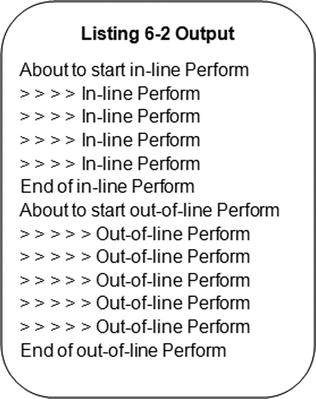
![]() ANS 85 In-line PERFORMs were only introduced as part of the ANS 85 COBOL specification. In older legacy systems, the loop body is always out of line.
ANS 85 In-line PERFORMs were only introduced as part of the ANS 85 COBOL specification. In older legacy systems, the loop body is always out of line.
In an out-of-line PERFORM, the loop body is a separate paragraph or section. This is the equivalent, in other languages, of having a procedure, function, or method invocation inside the loop body of a while or for construct.
When a loop is required, but only a few statements are involved, you should use an inline PERFORM. When a loop is required, and the loop body executes some specific task or function, out-of-line code should be used. The paragraph name chosen for the out-of-line code should identify the task or function of the code.
PERFORM..UNTIL (see Figure 6-3) is the third format of the PERFORM verb. This format implements both pre-test and post-test iteration in COBOL. It is the equivalent of Java’s while and do..while or Pascal’s While and Repeat..Until looping constructs.

Figure 6-3. Metalanguage for PERFORM format 3
Pre-test and post-test iteration structures seem to be strangely implemented in many languages. Some languages confuse when the test is done with how the terminating condition is tested (Pascal’s While and Repeat structures, for example). In many languages, the test for how the loop terminates emphasizes what makes the loop keep going, rather than what makes it stop. Although this may make formal reasoning about the loop easier, it does not come across as an entirely natural way of framing the question. In your day-to-day life, you do not say, “Heat the water while the water is not boiled” or “Pour water into the cup while the cup is not full.”
Pre-test and post-test looping constructs are one area where COBOL seems to have things right. Whether the loop is pre-test or post-test, it is separated from how the terminating condition is tested; and the test for termination emphasizes what makes the loop stop, rather than what makes it keep going. In COBOL you might write
PERFORM ProcessSalesFile WITH TEST BEFORE
UNTIL EndOfSalesFile
or
PERFORM GetNextCharacter WITH TEST AFTER
UNTIL Letter = "s"
Notes on PERFORM..UNTIL
If you use the WITH TEST BEFORE phrase, PERFORM behaves like a while loop and the condition is tested before the loop body is entered. If you use the WITH TEST AFTER phrase, PERFORM behaves like a do..while loop and the condition is tested after the loop body is entered. The WITH TEST BEFORE phrase is the default and so is rarely explicitly stated.
How PERFORM..UNTIL Works
Although flowcharts are generally derided as a program-design tool, they are very useful for showing flow of control. The flowcharts in Figure 6-4 and Figure 6-5 show how the WITH TEST BEFORE and WITH TEST AFTER variations of PERFORM..UNTIL work.

Figure 6-4. Pre-test loop

Figure 6-5. Post-test loop
Note that the terminating condition is checked only at the beginning of each iteration (PERFORM WITH TEST BEFORE) or at the end of each iteration (PERFORM WITH TEST AFTER). If the terminating condition is reached in the middle of the iteration, the rest of the loop body is still executed. The terminating condition cannot be checked until all the statements in the loop body have been executed. COBOL has no equivalent of the break command that allows control to break out of a loop without satisfying the terminating condition.
PERFORM..VARYING (see Figure 6-6) is the final format of the PERFORM verb.
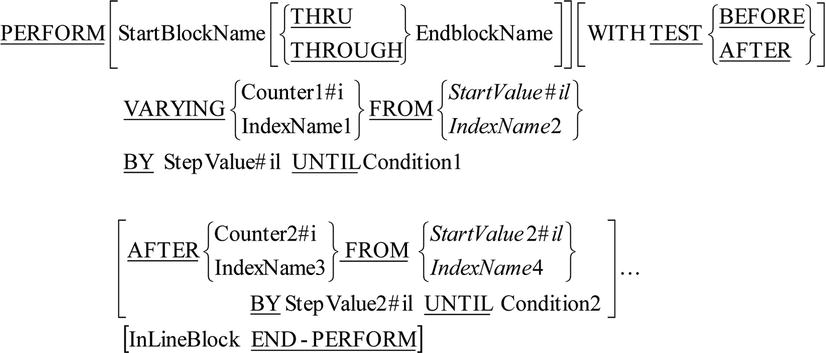
Figure 6-6. Metalanguage for PERFORM format 4
PERFORM..VARYING is used to implement counting iteration. It is similar to the for construct in languages like Pascal, C, and Java. However, there are some differences:
- Most languages permit only one counting variable per loop instruction. COBOL allows up to three. Why only three? Before ANS 85 COBOL, tables were allowed only a maximum of three dimensions, and PERFORM..VARYING was used to process them.
- Both pre-test and post-test variations of counting iteration are supported.
- The terminating condition does not have to involve the counting variable. For instance:
PERFORM CountRecordsInFile
VARYING RecordCount FROM 1 BY 1 UNTIL EndOfFile
The inline version of PERFORM..VARYING cannot take the AFTER phrase. This means only one counter may be used with an inline PERFORM.
When you use more than one counter, the counter after the VARYING phrase is the most significant, that after the first AFTER phrase is the next most significant, and the last counter is the least significant. Just like the values in an odometer, the least-significant counter must go through all its values and reach its terminating condition before the next-most-significant counter can be incremented.
The item after the word FROM is the starting value of the counter (initialization). An index item is a special data item. Index items are examined when tables are discussed.
The item after the word BY is the step value of the counter (increment). It can be negative or positive. If you use a negative step value, the counter should be signed (PIC S99, for instance). When the iteration ends, the counters retain their terminating values.
The WITH TEST BEFORE phrase is the default and so is rarely specified.
How PERFORM..VARYING Works
Figure 6-7 shows the flowchart for PERFORM..VARYING..AFTER. Because there is no WITH TEST phrase, WITH TEST BEFORE is assumed. The table shows the number of times the loop body is processed and the value of each counter as displayed in the loop body. The terminating values of the counters are also given.
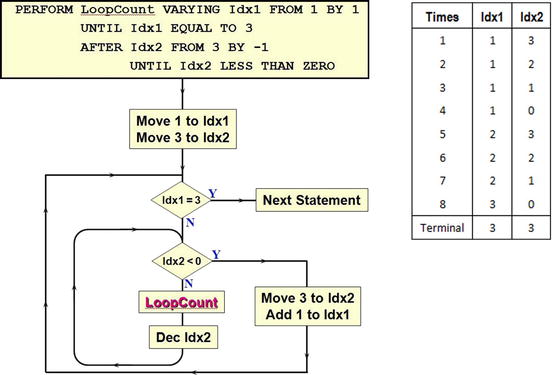
Figure 6-7. PERFORM..VARYING..AFTER
Note how the counter Idx2 must go through all its values and reach its terminating value before the Idx1 counter is incremented. An easy way to understand this is to think of it as an odometer. In an odometer, the units counter must go through all its values 0–9 before the tens counter is incremented.
Many of the example programs in this book provide a gentle preview of language elements to come. Listing 6-3 previews edited pictures. Examine the description of PrnRepCount provided by its picture, and review the output produced. Can you figure out how the edited picture works? Why do you think it was necessary to move RepCount to PrnRepCount? Why not just use the edited picture with RepCount?
Listing 6-3. Using PERFORM..VARYING for Counting
IDENTIFICATION DIVISION.
PROGRAM-ID. Listing6-3.
AUTHOR. Michael Coughlan.
DATA DIVISION.
WORKING-STORAGE SECTION.
01 RepCount PIC 9(4).
01 PrnRepCount PIC Z,ZZ9.
01 NumberOfTimes PIC 9(4) VALUE 1000.
PROCEDURE DIVISION.
Begin.
PERFORM VARYING RepCount FROM 0 BY 50
UNTIL RepCount = NumberOfTimes
MOVE RepCount TO PrnRepCount
DISPLAY "counting " PrnRepCount
END-PERFORM
MOVE RepCount TO PrnRepCount
DISPLAY "If I have told you once, "
DISPLAY "I've told you " PrnRepCount " times."
STOP RUN.

![]() Answer RepCount can’t be an edited picture because an edited picture contains non-numeric characters (spaces, in this case), and you can’t do computations with non-numeric characters. You have to do the computations with the numeric RepCount and then move it to the edited field PrnRepCount when you want it printed.
Answer RepCount can’t be an edited picture because an edited picture contains non-numeric characters (spaces, in this case), and you can’t do computations with non-numeric characters. You have to do the computations with the numeric RepCount and then move it to the edited field PrnRepCount when you want it printed.
The explanation of the operation of PERFORM..VARYING..AFTER compares the construct to an odometer. The program in Listing 6-4 reinforces this idea by using PERFORM..VARYING to emulate an odometer. The program uses both out-of-line and inline versions of PERFORM..VARYING. Notice that when the inline variation is used, you cannot have an AFTER phrase but must instead use nested PERFORMs just as in Java or Pascal. Because the output is voluminous, only the final part is shown here.
Listing 6-4. Odometer Simulation
IDENTIFICATION DIVISION.
PROGRAM-ID. Listing6-4.
AUTHOR. Michael Coughlan.
DATA DIVISION.
WORKING-STORAGE SECTION.
01 Counters.
02 HundredsCount PIC 99 VALUE ZEROS.
02 TensCount PIC 99 VALUE ZEROS.
02 UnitsCount PIC 99 VALUE ZEROS.
01 Odometer.
02 PrnHundreds PIC 9.
02 FILLER PIC X VALUE "-".
02 PrnTens PIC 9.
02 FILLER PIC X VALUE "-".
02 PrnUnits PIC 9.
PROCEDURE DIVISION.
Begin.
DISPLAY "Using an out-of-line Perform".
PERFORM CountMileage
VARYING HundredsCount FROM 0 BY 1 UNTIL HundredsCount > 9
AFTER TensCount FROM 0 BY 1 UNTIL TensCount > 9
AFTER UnitsCount FROM 0 BY 1 UNTIL UnitsCount > 9
DISPLAY "Now using in-line Perform"
PERFORM VARYING HundredsCount FROM 0 BY 1 UNTIL HundredsCount > 9
PERFORM VARYING TensCount FROM 0 BY 1 UNTIL TensCount > 9
PERFORM VARYING UnitsCount FROM 0 BY 1 UNTIL UnitsCount > 9
MOVE HundredsCount TO PrnHundreds
MOVE TensCount TO PrnTens
MOVE UnitsCount TO PrnUnits
DISPLAY "In - " Odometer
END-PERFORM
END-PERFORM
END-PERFORM
DISPLAY "End of odometer simulation."
STOP RUN.
CountMileage.
MOVE HundredsCount TO PrnHundreds
MOVE TensCount TO PrnTens
MOVE UnitsCount TO PrnUnits
DISPLAY "Out - " Odometer.
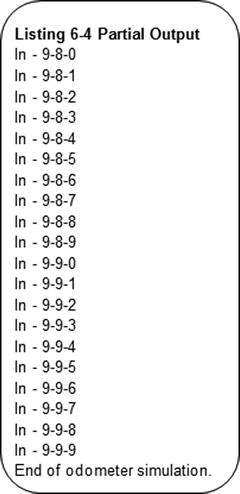
You might be wondering why the word FILLER is used in the description of Odometer. In COBOL, instead of having to make up dummy names, you can use FILLER when you need to reserve an area of storage but are never going to refer to it by name. For instance, in the data item Odometer, you want to separate the digits with hyphens, so you declare a character of storage for each hyphen and assign it the value -. But you will never refer to this part of Odometer by name. The hyphens only have significance as part of the group item.
Summary
This chapter examined the iteration constructs supported by COBOL. You learned the differences between COBOL’s version of pre-test and post-test iteration and those of other languages. I contrasted counting iteration in its PERFORM..VARYING..AFTER implementation, which has both pre-test and post-test variations, with the offerings of other languages. You also explored the ability to create open subroutines in COBOL, and I provided a rationale for using them.
Unleash your 2B pencil. It is exercise time again.
In the columns provided, write out what you would expect to be displayed on the computer screen if you ran the program shown in Listing 6-5. Use the Continue Run column to show what happens after the statement DISPLAY "STOP RUN should be here". has been executed.
Listing 6-5. Program to Test Your Knowledge of the PERFORM Verb
DATA DIVISION. Start Run Continue Run
IDENTIFICATION DIVISION.
PROGRAM-ID. Listing6-5.
AUTHOR. Michael Coughlan.
DATA DIVISION.
WORKING-STORAGE SECTION.
01 LoopCount PIC 9 VALUE 1.
01 LoopCount2 PIC 9 VALUE 1.
PROCEDURE DIVISION. Start Run Continue Run
P1.
DISPLAY "S-P1"
PERFORM P2
PERFORM P3
MOVE 7 TO LoopCount
PERFORM VARYING LoopCount
FROM 1 BY 1 UNTIL LoopCount = 2
DISPLAY "InLine - " LoopCount
END-PERFORM
DISPLAY "E-P1".
DISPLAY "STOP RUN should be here".
P2.
DISPLAY "S-P2"
PERFORM P5 WITH TEST BEFORE VARYING LoopCount
FROM 1 BY 1 UNTIL LoopCount > 2
DISPLAY "E-P2".
P3.
DISPLAY "S-P3"
PERFORM P5
PERFORM P6 3 TIMES
DISPLAY "E-P3".
P4.
DISPLAY "P4-" LoopCount2
ADD 1 TO LoopCount2.
P5.
DISPLAY "S-P5"
DISPLAY LoopCount "-P5-" LoopCount2
PERFORM P4 WITH TEST AFTER UNTIL LoopCount2 > 2
DISPLAY "E-P5".
P6.
DISPLAY "P6".
PROGRAMMING EXERCISE 1
In this programming exercise, you amend the program you wrote for the programming exercise in Chapter 5 (or amend the answer provided in Listing 5-11). That programming exercise required you to create a calculator program, but the program halted after only one calculation.
Amend the program so it runs until the user enters the letter s instead of an operator (+ - / *). The result of running the program is shown in the sample output in Example 6-9.
Example 6-9. Sample Run (User Input Shown in Bold)
Enter an arithmetic operator (+ - * /) (s to end) :*
Enter a single digit number -4
Enter a single digit number -5
Result is = 20.00
Enter an arithmetic operator (+ - * /) (s to end) :+
Enter a single digit number -3
Enter a single digit number -3
Result is = 06.00
Enter an arithmetic operator (+ - * /) (s to end) :-
Enter a single digit number -5
Enter a single digit number -3
Result is = -02.00
Enter an arithmetic operator (+ - * /) (s to end) :/
Enter a single digit number -5
Enter a single digit number -3
Result is = 00.60
Enter an arithmetic operator (+ - * /) (s to end) :s
End of calculations
PROGRAMMING EXERCISE 2
Write a program that gets the user’s name and a countdown value from the keyboard and then displays a countdown before displaying the name that was entered. Use PERFORM..VARYING to create the countdown.
The program should produce results similar to those shown in Example 6-10. For purposes of illustration, user input is in bold.
Example 6-10. Sample Run
Enter your name :-Mike Ryan
Enter the count-down start value :-05
Getting ready to display your name.
05
04
03
02
01
Your name is Mike Ryan
LANGUAGE KNOWLEDGE EXERCISE—ANSWER
DATA DIVISION. |
Start Run |
Continue Run |
PROGRAMMING EXERCISE 1—ANSWER
Listing 6-6. The Full Calculator Program
IDENTIFICATION DIVISION.
PROGRAM-ID. Listing6-6.
AUTHOR. Michael Coughlan.
*> Continually calculates using two numbers and an operator
*> Ends when "s" is entered instead of an operator.
DATA DIVISION.
WORKING-STORAGE SECTION.
01 Num1 PIC 9 VALUE ZERO.
01 Num2 PIC 9 VALUE ZERO.
01 Result PIC --9.99 VALUE ZEROS.
01 Operator PIC X VALUE SPACE.
88 ValidOperator VALUES "*", "+", "-", "/", "s".
88 EndOfCalculations VALUE "s".
PROCEDURE DIVISION.
Begin.
PERFORM GetValidOperator UNTIL ValidOperator
PERFORM UNTIL EndOfCalculations OR NOT ValidOperator
PERFORM GetTwoNumbers
EVALUATE Operator
WHEN "+" ADD Num2 TO Num1 GIVING Result
WHEN "-" SUBTRACT Num2 FROM Num1 GIVING Result
WHEN "*" MULTIPLY Num1 BY Num2 GIVING Result
WHEN "/" DIVIDE Num1 BY Num2 GIVING Result ROUNDED
END-EVALUATE
DISPLAY "Result is = ", Result
MOVE SPACE TO Operator
PERFORM GetValidOperator UNTIL ValidOperator
END-PERFORM
DISPLAY "End of calculations"
STOP RUN.
GetValidOperator.
DISPLAY "Enter an arithmetic operator (+ - * /) (s to end) : "
WITH NO ADVANCING
ACCEPT Operator.
GetTwoNumbers.
DISPLAY "Enter a single digit number - " WITH NO ADVANCING
ACCEPT Num1
DISPLAY "Enter a single digit number - " WITH NO ADVANCING
ACCEPT Num2.
PROGRAMMING EXERCISE 2—ANSWER
Listing 6-7. Uses PERFORM..VARYING to Display a Countdown from XX to 01
IDENTIFICATION DIVISION.
PROGRAM-ID. Listing6-7.
AUTHOR. Michael Coughlan.
DATA DIVISION.
WORKING-STORAGE SECTION.
01 UserName PIC X(20).
01 StartValue PIC 99 VALUE ZEROS.
01 Countdown PIC 99 VALUE ZEROS.
PROCEDURE DIVISION.
DisplayCountdown.
DISPLAY "Enter your name :- " WITH NO ADVANCING
ACCEPT UserName
DISPLAY "Enter the count-down start value :- " WITH NO ADVANCING
ACCEPT StartValue
PERFORM VARYING Countdown FROM StartValue BY -1 UNTIL Countdown = ZERO
DISPLAY Countdown
END-PERFORM
DISPLAY "Your name is " UserName
STOP RUN.
References
1. Tompkins HE. In defense of teaching structured COBOL as computer science (or, notes on being sage struck). ACM SIGPLAN Notices. 1983; 18(4): 86-94.
2. Baldwin, RR. A note on H.E. Tompkins’s minimum-period COBOL style. ACM SIGPLAN Notices. 1987; 22(5): 27-31. http://doi.acm.org/10.1145/25267.25273
doi: 10.1145/25267.25273
3. Compiled and run at compileoneline.com—Execute BASIC Program Online (Yabasic 2.9.15). www.compileonline.com/execute_basic_online.php
